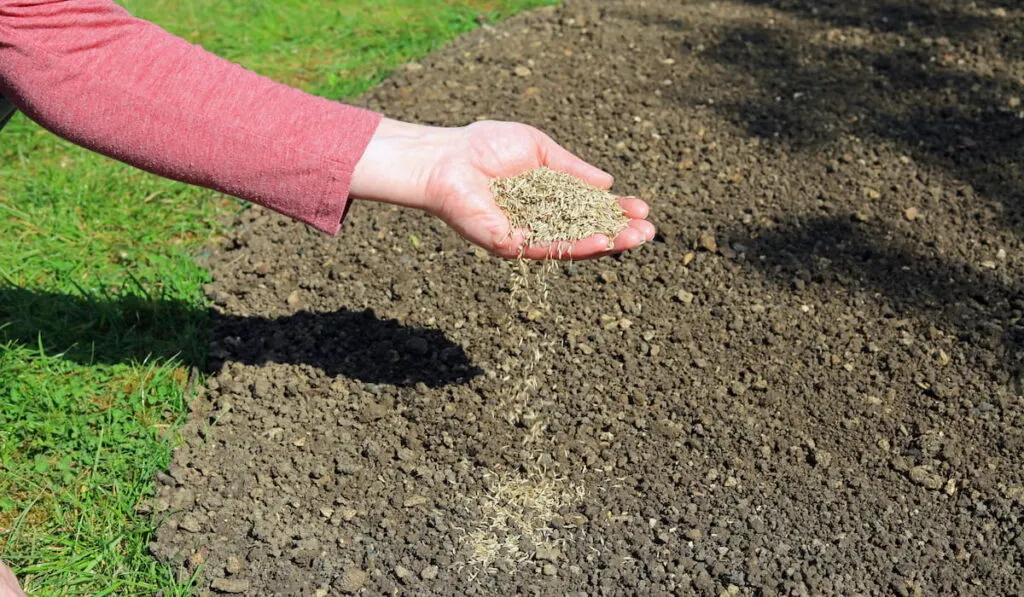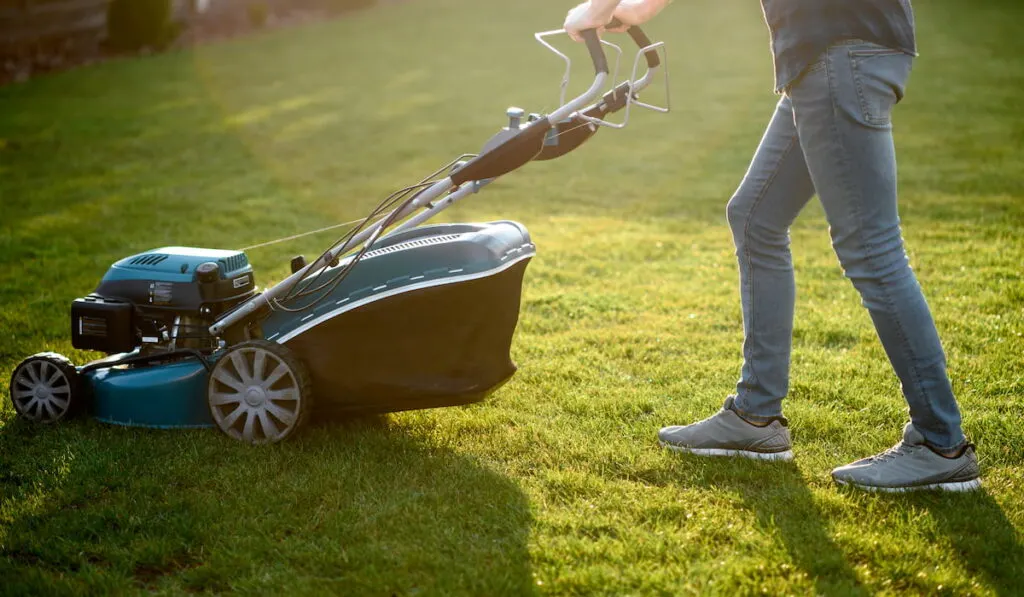Are you thinking of creating a beautiful lawn in your yard or looking to improve your existing turf?
Many people choose to introduce seeds instead of laying down new sod. Planting seeds can seem like a lot less work than installing all new sod. But if you want to start your lawn from seeds, how do you actually plant the seeds?
Can you just sprinkle grass seed on your lawn?

You can choose to distribute seeds on your lawn without covering them or caring for them in great detail, but the germination rate of your seeds will be slightly slower. This will cause the lawn to grow in much more slowly.
Starting a lawn from seeds can be easy and effective so long as you care for the plants properly.
Let’s take a closer look at how to care for your lawn, the best seeds for the task, and how you can improve the germination rate of your seeds.
Table of Contents
How to Grow New Grass on Your Lawn
Improving your yard with fresh sod can be backbreaking and expensive work. Many people choose to start their lawn out with grass seeds instead.
But how can you encourage your new grass to grown in properly? You can choose to spread grass seeds fresh on new ground or spread new seeds over existing grass to fill in your lawn.
Spreading Grass Seeds for a New Lawn
Spreading plant seeds on the ground has been a traditional and natural way of growing plants new plants (not just grass). When seeds come in contact with the soil and moisture, they germinate and start growing.
Grass seed can be spread on fresh ground to start a new lawn. But if you scatter the seeds on the soil without proper covering and nutrients, not all of the seeds will grow. The seed embryo may remain dry while exposed to the air, and without moisture, it will not germinate.
Also, animals such as birds and small mammals may eat some of the seeds they find and reducing the rate of grass seed survival. For your lawn to be fully established, you need to cover the seeds with a thin layer of soil, compost, or dirt.

Overseeding New Seeds on Existing Grass
Overseeding is when you do not remove old grass growing on the ground and spread seeds over them.
People overseed their lawns for various reasons including:
- New Grass Species: If you are tired of the grass in your current lawn, you can overseed the old grass to introduce a new species.
- Change of Season: Some grasses are summer annuals (meaning they live for one year and prefer summer months) while others are winter annuals. You may need to replace the old grass with new grass species as the seasons change.
- Filling Bare Spaces: If there are patches or bare spaces in your lawn, you can overseed the few grasses growing on those spaces to fill in each space.
Do not overseed if there are problems in your soil. For example, if the existing grasses are dying, you should look for the root of the problem before you reseed or overseed.
How to Prepare a Lawn
Before you put down your seeds, you should prepare your lawn and the soil for the best possible outcome. Here are a few tips to prep your lawn for new growth:

- Check Soil Tilth: Soil tilth is the general conditions of soil that support plant growth such as pH, fauna, drainage, and aeration. Grasses prefer soil with a pH of 6.2-7.0. The soil should be well-drained and aerated.
- Clear Trash and Weeds: Weeds can compete with grasses for nutrients, stunting new seed growth. Trash can contaminate the soil creating an unfit environment.
- Solarize the Soil: Soil solarization is the process of wetting the soil and covering it with a clear transparent tarp so that the heat of the sun becomes trapped in the soil and kills weed seeds. This ensures that weeds do not compete with your new grasses.
- Map Out Planting: If you are growing multiple grass species, map out the soil before you start spreading your grass seeds for a planned arrangement or proper blending.
Caring for Your Lawn
Once your seeds are planted, there are a few extra tips you can keep in mind to ensure proper growth for your new grass.
- Feed: Put down grass-specific fertilizers (which are not as strong as other fertilizers) for them to grow properly.
- Water: Regularly water your grass seeds to ensure timely germination.
- Mowing: Let your grass grow at least 3-4 inches in height before mowing. Do not cut your lawn very short as this can affect the health of the plants.

Choosing a Grass Species for Planting
Finding the best grass species for your lawn primarily depends on your region. Plant the right seeds for your seasons and climate for the best results.
Here, we’ll share the best grasses for regions throughout the United States
Northeast Region
If you live in the northeast, you will need cool-seasoned grasses for your lawn. Examples are:
- Fescues
- Ryegrasses
- Bluegrasses
Note that Kentucky bluegrass spreads fast but has a relatively shallow root system.
Midwest Region
Do you live in the Midwest region? Here are some recommended grass species:
- Bluegrass
- Perennial ryegrass
Most perennial ryegrasses in this region have high resistance to pests.
Southeast Region
The southeast tends to be hot and humid. Try seeding or planting with:
- Bermudagrass
- Ryegrass
While ryegrass dies in summer, bermudagrass turns brown but survives.
Deep South and Gulf Coast Region
Going further south, lawns will need grasses that are resilient in hotter and more humid climates. These can include:
- Bahiagrass
- Centipede Grass
Note that centipede grasses grow slowly and but are tolerant of drought and high temperatures.
Southwest Region
In the southwest United States, the temperatures can get extremely high but the air remains arid. Some grasses that thrive in these conditions include:
- Bermudagrass
- Ryegrass
Resilient bermudagrass is the most common in this region.

Pacific Northwest Region
This region has diverse growing conditions with a blend of cooler, rainy, and arid climate and differences in elevation. Generally, these grasses are a good fit in the Pacific northweset:
- Bluegrass
- Tall fescues
- Ryegrass
Final Thoughts
While you can start your lawn with sod or turf, the best way to start a lawn is by planting seeds. While you can spread the seeds on the surface of the soil and let them naturally grow, you should cover the seeds and ensure proper watering for a higher germination rate and a successful lawn.
Sources
- https://www.jonathangreen.com/resources/will-grass-seed-grow-if-not-covered.html
- https://homeguides.sfgate.com/planting-new-grass-top-old-grass-77374.html
- https://www.atlantalandscapingmatters.com/will-grass-seed-grow-if-just-thrown-on-the-ground.html
- https://www.lovethegarden.com/uk-en/article/7-lawn-care-tips
- https://www.pennington.com/all-products/grass-seed/resources/recommended-grasses-for-regional-climates
